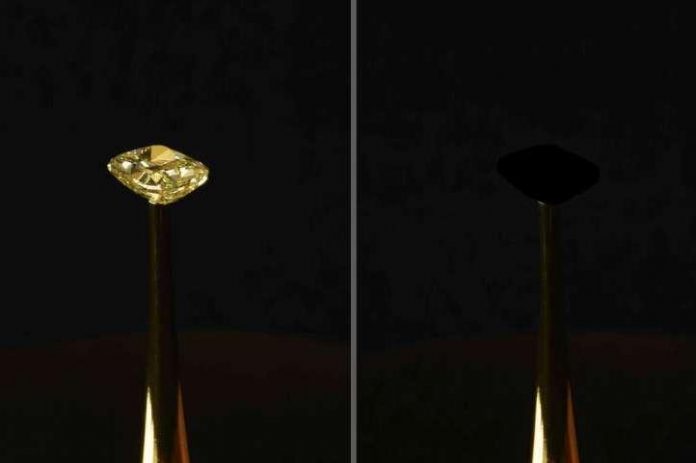Researchers at the Massachusetts Institute of Technology (MIT) have created a material that they claim is 10 times blacker than anything discovered before.
A pair of academics at MIT in the US discovered this when they decided to grow tiny carbon nanofibres on a slice of aluminium washed in a briny solution. When they measured the optical absorption, they found that the material sucked in a whopping 99.995 per cent of light.
The scientists had actually been experimenting with ways to grow CNTs on electrically conductive materials — such as aluminium — to boost their electrical and thermal properties. The color of the resulting material surprised the team, and they only realized what they had invented after they measured its optical reflectance.
The discovery is currently being showcased at an art exhibit titled “The Redemption of Vanity” at the New York Stock Exchange, where a 16.78-carat natural yellow diamond has been coated in the material. Instead of a brilliant, sparkling gem, the stone — which is worth an eye-watering $2 million — appears as a flat, black void.
However, the team says the material has practical applications, too. According to Brian Wardle, professor of aeronautics and astronautics at MIT, it could be used in optical blinders that reduce unwanted glare, to help space telescopes spot orbiting exoplanets. And, he says, the material could get even blacker still.
Before MIT developed what it called the “blackest black” material to date, Surrey NanoSystems claimed that title with its original Vantablack low-temperature carbon nanotube discovery. Surrey’s material was capable of absorbing 99.96 percent of light, although its scientists claim the company’s second generation concept could be even darker than that (even if spectrometers can’t apparently measure it). That hasn’t stopped BMW coating one of its cars in it, though.
“There are optical and space science applications for very black materials, and of course, artists have been interested in black, going back well before the Renaissance,” Wardle says. “Our material is 10 times blacker than anything that’s ever been reported, but I think the blackest black is a constantly moving target. Someone will find a blacker material, and eventually we’ll understand all the underlying mechanisms, and will be able to properly engineer the ultimate black.”
















So excited by the technology and developing minds that brought this exquisite masterpiece hopefully now military operations will benefit from using this product if they decide to invest in a new camouflage suit perhaps even in machinery aswell i think maybe this would make a perfect enhancer to help with coating cancer cells aswell like the nano tech bot works great for tricking the system into providing it a more decent structure/performance.#my ideasbythewaynostealing.thx